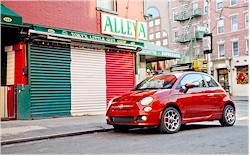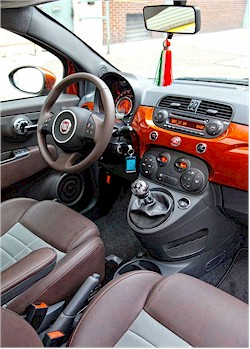
Fri 2/18/2011
Viva Italia: 2012 Fiat 500
It takes all of two seconds to see that the new 500 is a whole new cannoli. Even if you ignore its adorable styling inside and out (and that's a tall order), it's a magnificent piece of engineering.
Viva Italia: 2012 Fiat 500
Automobile Magazine; By Jason Cammisa; From the March, 2011 Issue
 |
| Photos courtesy of automobilemag.com |

It's quite a shock to see that New York's Little Italy -- once a thirty-block neighborhood that was home to a good portion of the city's 400,000 Italians -- has dwindled to three blocks. The tenement my great-grandparents lived in still has an Italian restaurant on the first level, but its cooking is for tourists, not hungry immigrants. Most everything else on Mulberry Street plays to tourists, too, even the Italian American Museum, whose founder, Dr. Joseph Scelsa, tells me something that I'll hear, both spoken and in my head, as I talk to off-the-boat Italians about the differences between us and Italy: "Italian Americans are in a time warp. They still think of Italy the way it was when their ancestors arrived here." Neither he nor Francesco Teoli, the Italian-born owner of an exotic-car shop who braved the bitterly cold drive from Long Island in his customer's heaterless original 500, is amused by the tricolori tassel I hung from the new car's rearview mirror. And when I point out that his customer's car has a red horn hanging from its mirror, he sneers: "Typical American." I'm glad he didn't see that my 500's trunk was full of boxes of ravioli or notice the dirty, tongue-in-cheek license plate I put on it.
We headed out onto the salt-covered streets of New York, and each and every time I heard the words "Fix It Again, Tony," Scelsa's theory about Italian Americans was proved correct. Not that you can blame Americans for their preconceived notions of modern Fiats. The last time the brand was sold here, they were the miserable cars that, in the words of my father, "your grandfather kicked and cursed at."
It takes all of two seconds to see that the new 500 is a whole new cannoli. Even if you ignore its adorable styling inside and out (and that's a tall order), it's a magnificent piece of engineering. With the possible exception of Fiat's clever but clattery Multiair variable valve lift system, there are no technological revelations here -- just a really good car. The 1.4-liter engine produces 101 hp, 98 lb-ft of torque, and a good chunk of noise under the hood-but it's never harsh, always responsive, and has a commendably robust torque curve. An optional Aisin six-speed automatic is exclusive to the North American 500, but the standard five-speed manual is a model of city-driving habitability, with a light clutch and a shifter sticking out of the dashboard less than two fist-widths away from the steering wheel.
There is no steering feel to speak of -- that wheel could be the least talkative Italian in history -- but the ratio is suitably quick and helps you fling the short-wheelbase Fiat around corners and weave around jaywalkers. New York's old-world roads, pockmarked by potholes that could swallow a moped whole, don't seem to bother the 500. Our Sport test car, with sixteen-inch wheels and a firmer suspension, remains amazingly composed over bumps even at crazed-taxicab speeds. The small amount of noise that does filter into the cabin is easily drowned out by the powerful Bose sound system.
Despite its rame paint (rame is the Italian word for "copper"; back in the day, Fiat might have more appropriately called this color ruggine, or "rust"), our 500 didn't exactly stop traffic. Clearly, it couldn't possibly look any more adorable, so we'll blame Manhattan's typical automotive ambivalence and Mother Nature's frigid temperatures and high winds. Aside from being cold, those New Yorkers who did notice the 500 had a few things in common. Once we filtered through the hundreds of "cutes," we noticed that the most enthusiastic tended to be Italian American. All of them seemed to know that the car wasn't supposed to be out for another few months. Without exception, perhaps out of fear of confusing this little beauty with a bad Ford Taurus, they referred to it as the Cinquecento (chin-kwah-CHEN-toe), not the "five hundred."
In its journey to the Nuovo Mondo (that would be here), the Nuova 500 has stayed remarkably true to its original design. This is especially impressive considering that it was never intended for our market. Our 500 will be produced at Chrysler's plant in Toluca, Mexico, and Fiat's engineers took advantage of the need to create new tooling to make some enhancements to the 500's front and rear suspension. Revised tuning gives our Cinquecento a smootherride, according to Fiat. The front and rear bumpers are new -- the former allowing for additional engine cooling. Significant improvements were made to the 500's crashworthiness, including moving the fuel-filler door forward and fitting seven air bags to the interior. The only remaining visible changes involve adjustments to adhere to U.S. lighting regulations. The weight gain over the European model is a palatable 140 pounds
Despite its small size and light weight, the 500 doesn't feel small from behind the wheel. You'd certainly never call it an econobox-it's more like a dime-size high-end fashion statement. The most obvious clue that you're driving a car so diminutive is the driving position, which keeps your feet close to your body. There's abundant headroom, though, and the relatively high seat and low dash give the driver a great, commanding view of the outside. The rear seats, replete with pill-shaped headrests to match the fronts, are far better to look at than to sit on, but four adults can fit in the 500 in a pinch. And we know how Italians love to pinch.
There are thoughtful and artful details everywhere-from the concentric gauges to the body-colored dash insert. At night, every one of the 500's buttons and displays is illuminated in exactly the same shade of amber. That's a level of detail that the Fiat of our collective memory would never get right-and some of today's best car companies can't manage. If the 500 has one ergonomic foible, it's that the key is painfully difficult to insert. As a Mafia chase car, you'd be better off in something else, lest you wind up getting whacked while fumbling with your ignition key.
Ah, back to the stereotypes. That was a joke, of course, but there is an almost Mafia-like code of silence among the media where Fiat's acquisition of Chrysler is concerned. It seems we're all thinking it, but we're afraid to say it: how is this ever supposed to work? The two companies' products are too different. The markets are too different. No American has ever gotten out of a Fiat Grande Punto and thought, "Man, that'd make a great subcompact Dodge." And no Italian has ever driven a Sebring convertible and thought it would look good parked in front of the Trevi Fountain.
Then there's the 500. Even after fourteen hours behind the wheel in miserable Manhattan traffic, I want one, badly. Almost everyone we spoke to wants one, too, just because of the way it looks. Obviously, there's little chance that the little Fiat will wind up on our country's best-seller list; differences in geography and culture and tastes prevent that. But to the group of people who don't find Pizza Hut's stuffed-crust pepperoni all that appealing, it's nice to know that a thin-crust, Neapolitan, wood-fired pizza Margherita is available.
And even if the whole Chrysler/Fiat thing makes no sense, as these little cars assimilate into mainstream American car culture, we'll look back at this moment as the start of a new Italian car culture-one where Tony doesn't have to fix anything and where we're finally getting a taste of the delicacies that real Italians have been enjoying all along.
2012 Fiat 500
PRICE: $16,000/$19,500 (base/as tested, est.)
Powertrain
ENGINE: 16-valve SOHC I-4
DISPLACEMENT: 1.4 liters (83 cu in)
HORSEPOWER: 101 hp @ 6500 rpm
TORQUE: 98 lb-ft @ 4000 rpm
TRANSMISSION: 5-speed manual
DRIVE: Front-wheel
Chassis
STEERING: Electrically assisted,
rack-and-pinion
SUSPENSION, FRONT: Strut-type, coil
springs
SUSPENSION, REAR: Torsion beam, coil
springs
BRAKES: Discs, ABS
TIRES: Pirelli Cinturato P7
TIRE SIZE: 195/45HR-16
Measurements
L x W x H: 139.6 x 64.1 x 59.8 in
WHEELBASE: 90.6 in
TRACK F/R: 55.4/55.0 in WEIGHT: 2350
lb
FUEL MILEAGE: 29/37 mpg (est.)
http://www.automobilemag.com/reviews/driven/1103_2012_fiat_500/index.html
The ANNOTICO Reports Can be
Viewed (With Archives) on:
![]() [Formerly
Italy at St Louis]
[Formerly
Italy at St Louis]